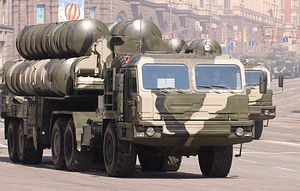The Chinese People’s Liberation Army’s (PLA) recent acquisition of Russian-made S-400 missile systems has considerably augmented what has already long been one of the world’s most formidable air defense networks, with wide-ranging implications for the balance of power in East Asia.
While Chinese air defense capabilities were negligible until the early 1990s, the acquisition of advanced Russian technologies, including several variants of the S-300, was key to building up an advanced network capable of protecting the country’s airspace from a potential air or missile attacks — shifting the balance of forces in the air strongly in Beijing’s favor. The S-400 today is set to complement existing air defense platforms such as the HQ-16 and HQ-17, while fielding a number of game-changing capabilities, including new surface-to-air missiles and anti-stealth technologies. Even without the support of other air defense and aerial assets, the S-400 alone poses a major threat not only to hostile aircraft operating within Chinese airspace, but also, due to its extreme range, to aircraft to well beyond Chinese shores.
While China’s acquisition of the S-400 is set to have considerable implications for a number of potential conflict zones, including the country’s ongoing disputes with Japan over the Senkaku/Diaoyu Islands and with India over the border region, it is in the Taiwan Strait where the weapon’s deployment may well have the greatest impact. The S-400 is able to engage a phenomenal 80 aircraft simultaneously, equivalent to approximately one-third of Taiwan’s fighting fleet, allocating two missiles per target. In addition, the missile system’s 48N6E2, 48N6DM/48N6E3, and 40N6 missiles retain ranges of 200 km, 250 km and 400 km respectively, all giving extensive coverage over Taiwanese airspace. Thus the PLA’s acquisition of the S-400 allows it to enforce an effective no fly zone over the territories under Taipei’s control in the event of cross-strait war.
It is critical to note when assessing its capabilities that the S-400 was designed largely in response to the United States’ development of advanced stealth aircraft, with the cash-strapped Russia forced to cancel Soviet era programs to develop stealth fighters of its own and instead rely on asymmetric surface-to-air batteries to ensure its continued ability to threaten the new American aircraft. Entering service just months after the U.S. Air Force’s F-22 Raptor, the lethal new American jet held the S-400 to extremely high standards. This implies that the missile platform is well within its limits to target non-stealthy older aircraft such as the F-15. Taiwanese jets today, considerably lighter, slower, lower flying than the F-15 and operating with high radar and heat signatures by the standards of modern combat jets, have an extremely poor level of survivability against the S-400 even at extreme ranges.
Taiwan’s fleet of unspecialized light multirole aircraft — six wings comprised of Mirage 2000 jets and F-5E Freedom Fighters (one wings each) as well as F-16A Fighting Falcons and indigenous F-CK Ching Kuo jets (two each) — lack even basic stealth technologies and use designs dating back to the 1970s or earlier. They will stand little chance of evading attacks by the new missile system.
Other than fighters, support aircraft such as the E-2 Hawkeye, while potentially highly effective force multipliers when operating at safe distances, will be extremely vulnerable as soon as they leave the ground, due to their poor maneuverability and bulky airframes . With the S-400’s missiles incoming at speeds of Mach 8.2, in the case of the 48N6E2, and Mach 14 in the case of the 48N6E3 and 40N6, the missiles can be launched from command posts on the Chinese mainland and will reach their targets over Taiwan in a matter of seconds.
While Taiwan’s air fleet already faced a considerable challenge operating against China’s existing air defense batteries such as the HQ-9B and elite air superiority fighters such as the J-11B and Su-35, the emergence of the S-400 not only eliminates an offensive or retaliatory strike role for Taiwan’s air fleet but it also seriously hinders its ability to undertake even very basic defensive operations. As Taiwan continues to invest heavily in costly but seemingly inconsequential modernizations for its aging fighters, from new cruise missiles to stronger radars, the armed forces would do well to consider the threat the S-400 poses to the continued viability of their fleet.
Possible counters to the new weapons system could include heavy investments in electronic warfare and potentially the acquisition of stealth fighters which, at least at extreme ranges, should retain a degree of survivability against the S-400. With the situation for Taiwan’s air force looking increasingly bleak, the military may well move to concentrate more heavily on acquiring and modernizing its own ground based surface-to-air missile systems as an asymmetric response – an effective means of denying the PLA Air Force access to its airspace even if its own fighter fleet remains grounded.
Abraham Ait is a military analyst and the founder of Military Watch Magazine.
































